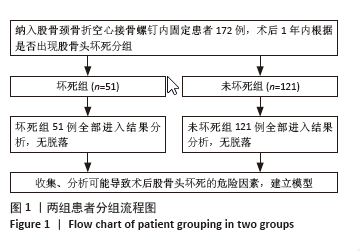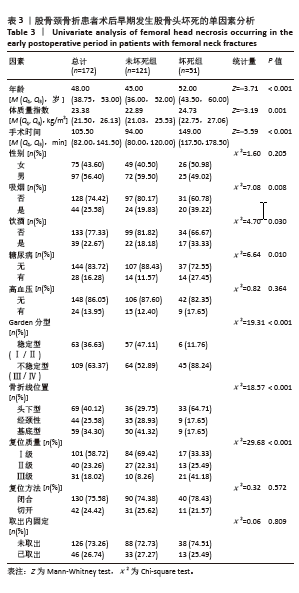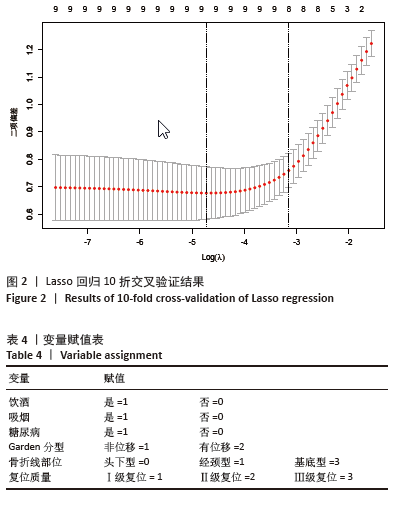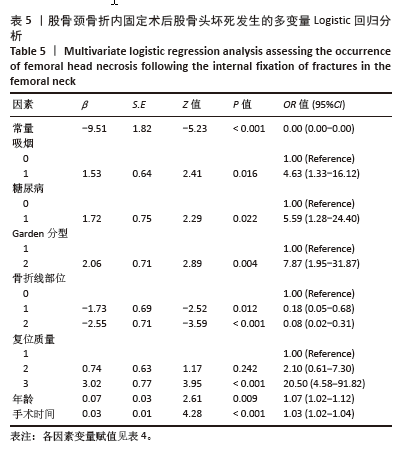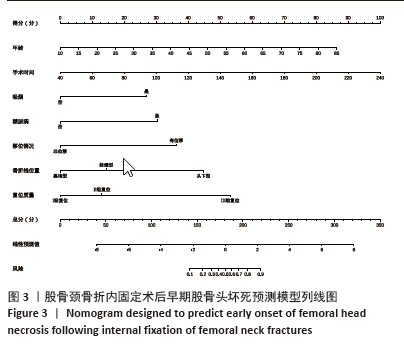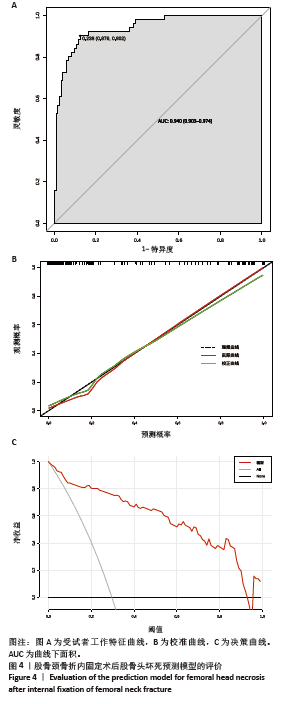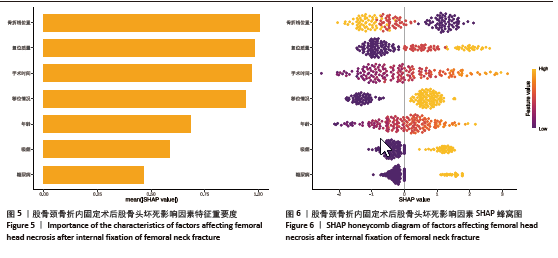1] 中华医学会骨科学分会创伤骨科学组,中国医师协会骨科医师分会创伤专家工作委员会.成人股骨颈骨折诊治指南[J].中华创伤骨科杂志,2018, 20(11):921-928.
[2] 张文彬,周琴,吕良友,等.股骨颈动力交叉钉系统和空心螺钉内固定治疗中青年股骨颈骨折的早期疗效对比[J].骨科,2024,15(4):357-361.
[3] EHLINGER M, MOSER T, ADAM P, et al. Early prediction of femoral head avascular necrosis following neck fracture. Orthop Traumatol Surg Res. 2011;97(1):79-88.
[4] 周咏辉,李磊,李冲,等.空心螺钉双平面垂直固定与倒三角固定治疗中青年PauwelsⅢ型股骨颈骨折的临床疗效分析[J].中国修复重建外科杂志,2024,38(8):961-967.
[5] BI ZG, WANG XM. Reviewing the surgery strategy for fracture neck of femur. Zhonghuawaikezazhi. 2019;57(11):804-806.
[6] 梁浩然,周新,杨彦飞,等.青壮年股骨颈骨折内固定后股骨头坏死的发病机制[J].中国组织工程研究,2022,26(3):456-460.
[7] SLOBOGEAN GP, SPRAGUE SA, SCOTT T, et al. Complications following young femoral neck fractures. Injury. 2015;46(3):484-491.
[8] 李志鹏,环大维,袁兆丰,等.老年股骨颈骨折患者术后死亡的危险因素及预测列线图的构建[J].中国组织工程研究,2024,28(21): 3361-3366.
[9] WOJCIECH K, TOMASZ P, ANDRZEJ Ś, et al. Avascular Necrosis of Femoral Head—Overview and Current State of the Art. Int J Environ Res Public Health. 2022;19(12):7348.
[10] XIA W, ZHANG A, QIU B, et al. Femoral neck fracture after femoral head necrosis: a case report and review of the literature. BMC Musculoskelet Disord. 2023;24(1). doi:10.1186/s12891-023-06992-9.
[11] PAPAKOSTIDIS C, PANAGIOTOPOULOS A, PICCIOLI A, et al.Timing ofinternal fixation of femoral neck fractures. A systematic review andmeta-analysis of the final outcome. Injury. 2015;46(3):
459-466.
[12] TANI T, ANDO W, FUKUSHIMA W, et al. Geographic distribution of the incidence of osteonecrosis of the femoral head in Japan and its relation to smoking prevalence. Mod Rheumatol. 2022;32(1):186-192.
[13] LAI SW, LIN CL, LIAO KF. Real-World Database Examining the Association Between Avascular Necrosis of the Femoral Head and Diabetes in Taiwan. Diabetes Care. 2019;42(1):39.
[14] WONGWAI T, WAJANAVISIT W, WORATANARAT P. Non-union and avascular necrosis of delayed reduction and screw fixation in displaced femoral neck fracture in young adults. J Med Assoc Thai. 2012;95 Suppl 10(95 Suppl 10):S120-S127.
[15] PERUMAL V, WOODLEY SJ, NICHOLSON HD. Neurovascular structures of the ligament of the head of femur. J Anat. 2019;234(6):778-786.
[16] 薛晨曦,荆珏华,徐杰,等.选择性血管造影评价股骨颈骨折后股骨头血供变化[J].临床骨科杂志,2014,17(2):149-151+154.
[17] LIU Y, LI MH, ZHANG M, et al. Femoral neck fractures: prognosis based on a new classification after superselective angiography. J Orthop Sci. 2013;18(3):443-450.
[18] KUMAR MN, BELEHALLI P, RAMACHANDRA P. PET/CT study of temporal variations in blood flow to the femoral head following low-energy fracture of the femoral neck. Orthopedics. 2014;37(6):e563-5e70.
[19] GADINSKY NE, KLINGER CE, SCULCO PK, et al. Femoral Head Vascularity: Implications Following Trauma and Surgery About the Hip. Orthopedics. 2019; 42(5):250-257.
[20] SEELEY MA, GEORGIADIS AG, SANKAR WN. Hip Vascularity: A Review of the Anatomy and Clinical Implications. J Am Acad Orthop Surg. 2016;24(8):515-526.
[21] WANG Y, MA JX, YIN T, et al. Correlation Between ReductionQuality of Femoral Neck Fracture and Femoral Head Necrosis Based on Biomechanics. Orthop Surg. 2019;11(2):318-324.
[22] CELIK B, KOSE A, MILCAN A, et al. Relation of femur fractures location with clinical outcomes in elderly patients. Acta Ortop Bras. 2023;31(spe1):e239997.
[23] WANG H, WU W, HAN C, et al. Prediction model of osteonecrosis of the femoral head after femoral neck fracture: machine learning–based development and validation study. JMIR Med Inform. 2021; 9(11):e30079.
[24] HU Y, YANG Q, ZHANG J, et al. Methods to predict osteonecrosis of femoral head after femoral neck fracture: a systematic review of the literature. J Orthop Surg Res. 2023;18(1):377.
[25] CONG B, ZHANG H. The association between three-dimensional measurement of posterior tilt angle in impacted femoral neck fractures and osteonecrosis of the femoral head. BMC Musculoskelet Disord. 2023;24(1):758.
[26] TANG Z, LI R, LU C, et al. Risk factors for avascular necrosis of the femoral head after developmental hip dislocation reduction surgery and construction of Nomogram prediction model. BMC Musculoskelet Disord. 2024;25(1):464.
[27] RANDELLI F, VIGANÒ M, LICCARDI A, et al. Femoral neck fractures: Key points to consider for fixation or replacement a narrative review of recent literature. Injury. 2023;54:S70-S77.
[28] LIN G, YANG D, SUI W. Clinical Effect of Open Reduction and Internal Fixation for Femoral Neck Fracture in Young Adults and Related Factors of Femoral Head Necrosis. J Environ Public Health. 2022;2022(1):2974830.
[29] YANG TJ, SUN SY, ZHANG L, et al. A delphi-based model for prognosis of femoral head collapse in osteonecrosis: a multi-factorial approach. J Orthop Surg Res. 2024;19(1):762.
[30] KONARSKI W, POBOŻY T, ŚLIWCZYŃSKI A, et al. Avascular necrosis of femoral head—overview and current state of the art. Int J Environ Res Public Health. 2022;19(12):7348.
[31] LIU Y, SONG W, LIANG H, et al. Comparison of femoral mechanics before and after internal fixation removal and the effect of sclerosis on femoral stress: a finite element analysis. BMC Musculoskelet Disord. 2022;23(1):930.
[32] LIU B, HOU G, YANG Z, et al. Machine learning models to predict osteonecrosis in patients with femoral neck fractures undergoing internal fixation. Injury. 2024;55(11):111830.
[33] QI BH, WANG XW, WANG XM, et al. Risk factors related with avascular necrosis after internal fixation of femoral neck fractures in children: a systematic review and meta-analysis. Front Pediatr. 2023;11:1188179.
[34] MEI J, LIU S, JIA G, et al. Finite element analysis of the effect of cannulated screw placement and drilling frequency on femoral neck fracture fixation. Injury. 2014;45(12):2045-2050.
[35] WANG W, LI Y, XIONG Z, et al. Effect of the number, size, and location of cannulated screws on the incidence of avascular necrosis of the femoral head in pediatric femoral neck fractures: a review of 153 cases. J Pediatr Orthop. 2022;42(3):149-157.
[36] MOON JK, LEE JI, HWANG KT, et al. Biomechanical comparison of the femoral neck system and the dynamic hip screw in basicervical femoral neck fractures. Sci Rep. 2022;12(1):7915.
[37] DE FRANCO S, IPPONI E, RUINATO AD, et al. Femoral neck fractures treated with cannulated screws: can surgeons predict functional outcomes and minimize the risk of necrosis? Acta Biomed. 2023;94(1):e2023013.
[38] ALSAYED MA, ALQHTANI MM, ALKHAMMASH ZM, et al. Hip Fracture, Causes, Classification, and Management: A Literature Review. World J Environ Biosci. 2021;10(2-2021):49-55.
[39] KOABAN S, ALATASSI R, ALHARBI S, et al. The relationship between femoral neck fracture in adult and avascular necrosis and nonunion: a retrospective study. Ann Med Surg. 2019;39:5-9.
[40] RANDELLI F, VIGANÒ M, LICCARDI A, et al. Femoral neck fractures: Key points to consider for fixation or replacement a narrative review of recent literature. Injury. 2023;54:S70-S77. |
